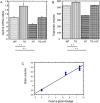Green tea polyphenols rescue of brain defects induced by overexpression of DYRK1A
- PMID: 19242551
- PMCID: PMC2645681
- DOI: 10.1371/journal.pone.0004606
Green tea polyphenols rescue of brain defects induced by overexpression of DYRK1A
Abstract
Individuals with partial HSA21 trisomies and mice with partial MMU16 trisomies containing an extra copy of the DYRK1A gene present various alterations in brain morphogenesis. They present also learning impairments modeling those encountered in Down syndrome. Previous MRI and histological analyses of a transgenic mice generated using a human YAC construct that contains five genes including DYRK1A reveal that DYRK1A is involved, during development, in the control of brain volume and cell density of specific brain regions. Gene dosage correction induces a rescue of the brain volume alterations. DYRK1A is also involved in the control of synaptic plasticity and memory consolidation. Increased gene dosage results in brain morphogenesis defects, low BDNF levels and mnemonic deficits in these mice. Epigallocatechin gallate (EGCG) - a member of a natural polyphenols family, found in great amount in green tea leaves - is a specific and safe DYRK1A inhibitor. We maintained control and transgenic mice overexpressing DYRK1A on two different polyphenol-based diets, from gestation to adulthood. The major features of the transgenic phenotype were rescued in these mice.
Conflict of interest statement
Figures





References
-
- Delabar JM, Theophile D, Rahmani Z, Chettouh Z, Blouin JL, et al. Molecular mapping of twenty-four features of Down syndrome on chromosome 21. Eur J Hum Genet. 1993;1(2):114–24. - PubMed
-
- Korenberg JR, Aaltonen J, Brahe C, Cabin D, Creau N, et al. Report and abstracts of the Sixth International Workshop on Human Chromosome 21 Mapping. Cold Spring Harbor, New York, USA. May 6–8,1996. Cytogenet Cell Genet. 1997;79(1–2):21–52. - PubMed
-
- Guimera J, Casas C, Pucharcos C, Solans A, Domenech A, et al. A human homologue of Drosophila minibrain (MNB) is expressed in the neuronal regions affected in Down syndrome and maps to the critical region. Hum Mol Genet. 1996;Sep;5(9):1305–10. - PubMed
-
- Tejedor F, Zhu XR, Kaltenbach E, Ackermann A, Baumann A, et al. Minibrain: a new protein kinase family involved in postembryonic neurogenesis in Drosophila. Neuron. 1995;Feb;14(2):287–301. - PubMed
Publication types
MeSH terms
Substances
LinkOut - more resources
Full Text Sources
Other Literature Sources
Medical

